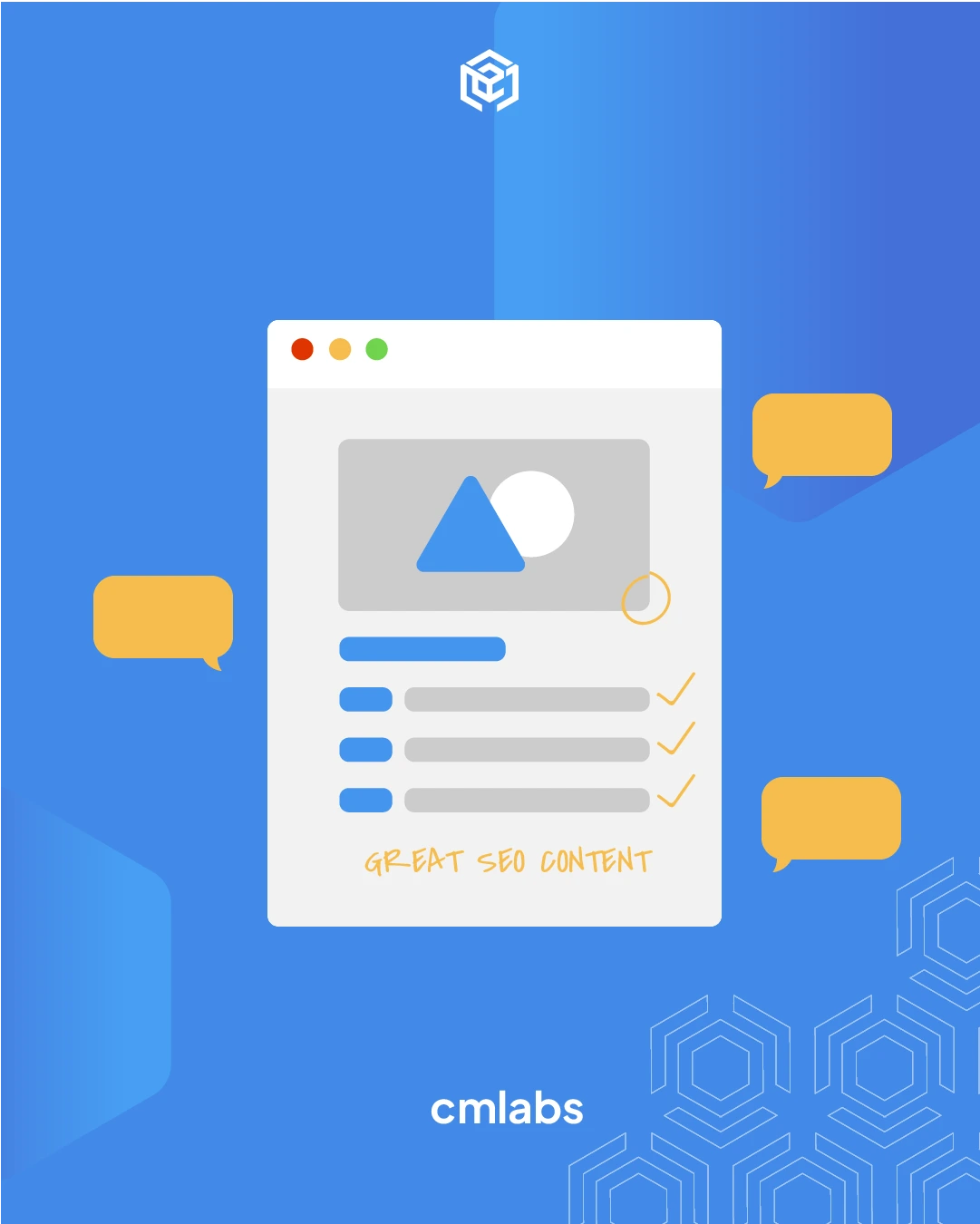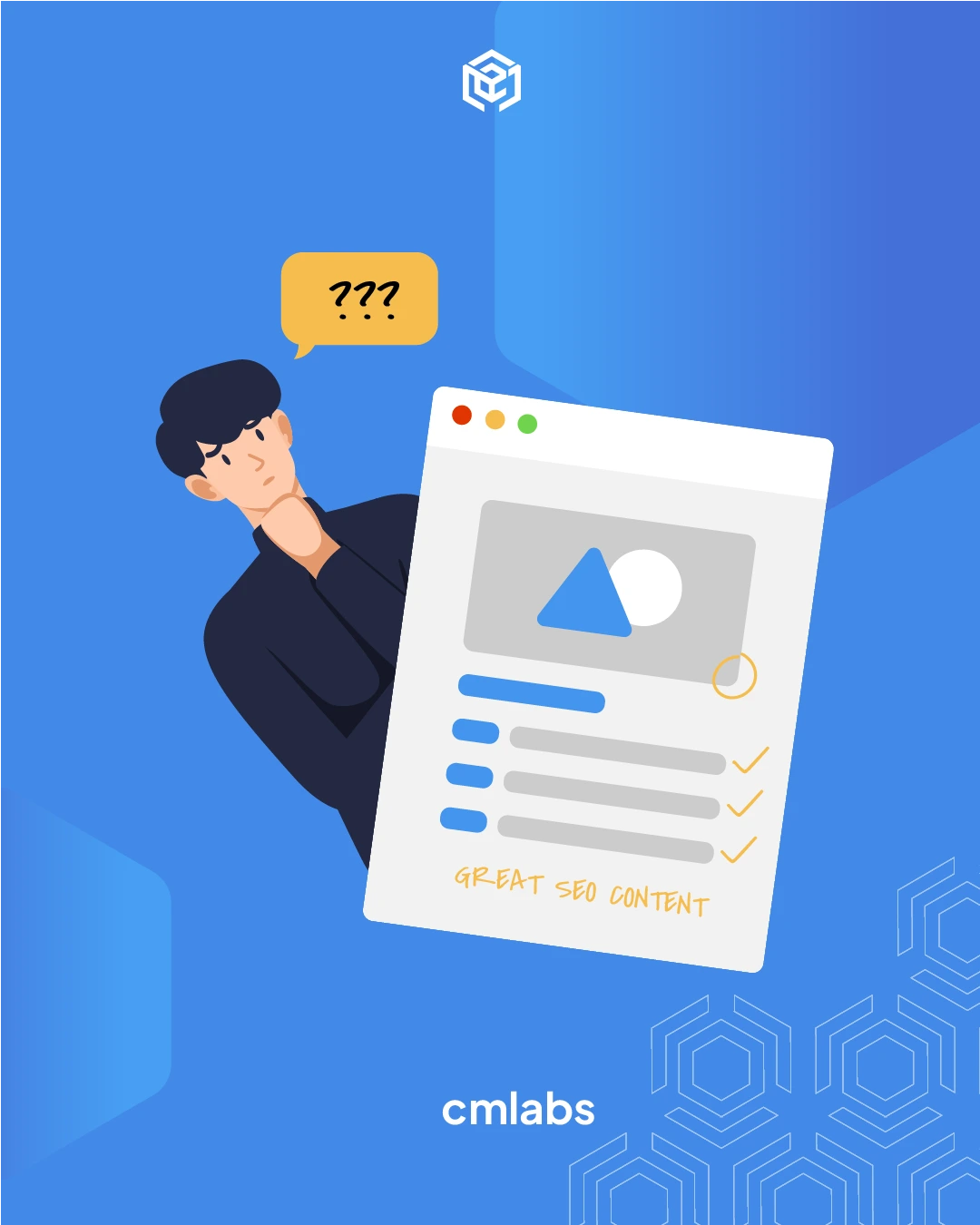We use cookies
This site uses cookies from cmlabs to deliver and enhance the quality of its services and to analyze traffic..
SEO SERVICES
Conduct in-depth technical website audits, strategically develop website projections, and increase your website authority.
ASO SERVICES
Elevate Your App’s Presence with Our Expert ASO Services – Boost Visibility and Drive Downloads!
WRITING SERVICES
We offer a variety of writing services to suit different business necessities. Reach broader audiences or lead specific industries? We've got you covered!
SEOlutions
A unified source of truth!
SEO & Digital Maternity Solution
SEO & Digital Maternity Solution: Leverage Cross-Platform Insights to Elevate Your Strategy with Expert Consultation
SEO & Digital Maternity Solution
Data Solution options:
Starting from Rp200 mio
Reinventing how a company get creative treatments
A new way to get your creative needs done. Agile team, efficient cost, and expedient way in a flexible yet scalable subscription plan!
Creative-as-a-Services
CaaS package options:
Based on Subscription
Pioneer in digital marketing software powerhouse
We’re excited to unveil our new range of Tech Solutions designed to drive your digital success. Whether you’re looking to enhance your website’s performance, streamline your tech stack, or unlock deeper insights from your data, we’ve got you covered.
Starting from Rp250 mio
Our Clients
Research and innovation center for digital transformation
Digital marketing combines technical skills and business knowledge at every stage. For marketing teams, improving budget management efficiency is crucial, as time is an invaluable resource that should be used wisely. At Sequence, we are dedicated to empowering you to optimize efficiency and strategic planning, ultimately enhancing the impact of your digital marketing efforts.
Subscription-based (IDR1,800/keyword)
Our Clients
BeyondSEO
References
SEO Tools for Webmasters
SEO Tools for Writers
SEO Tools
FIND THE SUITABLE PARTNERSHIP FOR YOUR COMPANY
Check out which cmlabs partnership program suits your company
WHITE LABEL SEO
for CorporateYour company is granted exclusive partnership rights to provide SEO services to our important clients, and we will provide a dedicated backend team to support your efforts.
AFFILIATE PROGRAM
for BizdevA new affiliate program is being introduced for skilled marketers and individuals with strong networks, offering commissions of up to 7% for generating profits independently.
DIGITAL AGENCY
for Marketing Partnerscmlabs is an essential partner for digital agencies, providing a unique selling proposition in Search Engine Optimization (SEO).
BACKLINK PARTNERSHIP
for Media / BloggerWe have a vast database of bloggers and media outlets across Indonesia, categorized by region and media type, giving our clients an edge in managing their media and SEO activities.
OFFICIAL TRAINING
We provide ongoing professional development and support to SEO professionals to ensure they are equipped to meet market demands.
JOIN AS CONTRIBUTOR
for Content WriterGreat opportunity for SEO Writers around the world. T&C applied!
ACADEMIC PARTNERSHIP
Through partnerships with universities in Indonesia, cmlabs has helped align academic curricula with industry demands.
Partnership
Sector & Industries
Tell us your SEO needs, our marketing team will help you find the best solution
As an alternative, you can schedule a conference call with our team
Schedule a Meeting?Contact
Notification
Survey
We use cookies
This site uses cookies from cmlabs to deliver and enhance the quality of its services and to analyze traffic..
Last updated: Aug 12, 2022
Robot.txt is a file used by search engines’ crawlers in your website to classify pages that people can visit. In certain cases, web developers provide a PUBLIC page for users, not search engines such as Google, Bing, and Yahoo.
The purpose of this file is a robot exclusion protocol. It is a de facto standard in the communication law and a border between websites and non-human users.
Robots exclusion protocol or robots txt allows web developers to decide in which part/file/folder of their website that can be accessed by bot or crawler.
Robot.txt provides instructions for bots. The web crawler will try to crawl robot.txt first before crawling all other pages in a domain. The instructions written on robot.txt will be carried out by the crawler such as no follow, do follow, or other instructions.
The crawler bot will follow the most specific set of instructions in the robots.txt file. If there are contradictory instructions in the file, the bot will follow more detailed instructions.
The functions of robot.txt are as follows:
One of the main functions of robot.txt is to control the crawler activity on the website. Without using robot.txt, crawlers will crawl all pages including duplicate content. If you don't allow bots to crawl it, then you'll need to add instructions to robot.txt
There are times when you don't want a page on your website to appear in the SERP for several reasons. Case in point, you are not targeting product subcategory pages to appear on the SERP. Therefore, you can instruct the crawler not to display it.
user-agent: Googlebot disallow: /login user-agent: Googlebot-news disallow: /media user-agent: Googlebot-image
Based on the syntax sample above, here is the explanation:
In general cases, robots.txt implementation is NOT VALID for a subdomain, protocol, and port. However, it will be VALID for all files in all of the sub-directories on the host, protocol, and port.
Check the sample location of the robots.txt file in the directory of the website server:
Valid Example
http://robots.co/robots.txt http://robots.co/folder/file/robots.txtInvalid Example
http://other.cmlabs.co/robots.txt https://cmlabs.co/robots.txt
http://cmlabs.co:8181/robots.txtWhen this page is published (on May 21st, 2020), the definition and implementation of the robots.txt are only applicable to Google. In another word, other search engines such as Bing, Yahoo, Yandex, etc do not always use the same standard.
However, a global standardization has been a discussion among the international communities.
Robots.txt is not the right file to be used to hide a file or page from the crawler of search engines.
The right answer for: what should we do to hide files from Google? Is by inserting nonindex tag.
<meta name="robots" content="noindex"> <meta name="googlebot" content="noindex">
RESPONSE HEADER
HTTP/1.1 200 OK (…) X-Robots-Tag: noindex (…)
On July, 1st 2019, Google through its official blog announced that robots.txt protocol was prepared to be the Internet standard. It means that all of the search engines will be agreed to this provision.
Robots Exclusion Protocol Draft
User-agent / bot
User-agent is a robot that is used by search engines to crawl all websites on the internet.
Find other important terms in the following SEO Terms:
A:
B:
C:
D:
E:
F:
G:
H:
I:
J:
K:
L:
M:
N:
O:
P:
Q:
R:
S:
T:
U:
V:
W:
X:
Y:
WDYT, you like my article?
Couldn't find result for "Mulki" try to search with different keyword
Suggestion:
Tell us your SEO needs, our marketing team will help you find the best solution
As an alternative, you can schedule a conference call with our team
Schedule a Meeting?



cmlabs Jakarta Jl. Pluit Kencana Raya No.63, Pluit, Penjaringan, Jakarta Utara, DKI Jakarta, 14450, Indonesia
(+62) 21-666-04470These strategic alliances allow us to offer our clients a wider range of SEO innovative solutions and exceptional service.

Psst! Hey there, SEO Stats and Tools SEO company! If you've ever planned of conquering the market, you've come to the right place!